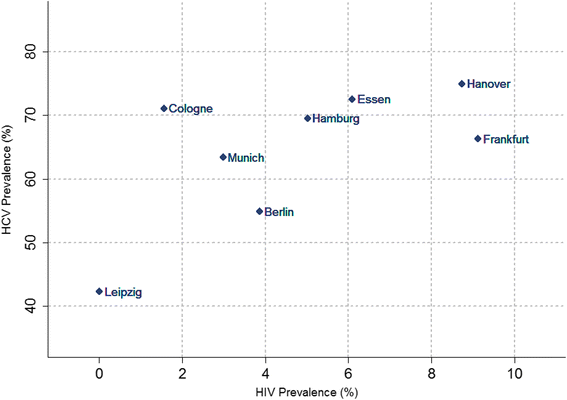High variability of HIV and HCV seroprevalence and risk behaviours among people who inject drugs: results from a cross-sectional study using respondent-driven sampling in eight German cities (2011-14)
- PMID: 27595567
- PMCID: PMC5011883
- DOI: 10.1186/s12889-016-3545-4
High variability of HIV and HCV seroprevalence and risk behaviours among people who inject drugs: results from a cross-sectional study using respondent-driven sampling in eight German cities (2011-14)
Abstract
Background: People who inject drugs (PWID) are at increased risk of acquiring and transmitting HIV and Hepatitis C (HCV) due to sharing injection paraphernalia and unprotected sex. To generate seroprevalence data on HIV and HCV among PWID and related data on risk behaviour, a multicentre sero- and behavioural survey using respondent driven sampling (RDS) was conducted in eight German cities between 2011 and 2014. We also evaluated the feasibility and effectiveness of RDS for recruiting PWID in the study cities.
Methods: Eligible for participation were people who had injected drugs within the last 12 months, were 16 years or older, and who consumed in one of the study cities. Participants were recruited, using low-threshold drop-in facilities as study sites. Initial seeds were selected to represent various sub-groups of people who inject drugs (PWID). Participants completed a face-to-face interview with a structured questionnaire about socio-demographics, sexual and injecting risk behaviours, as well as the utilisation of health services. Capillary blood samples were collected as dried blood spots and were anonymously tested for serological and molecular markers of HIV and HCV. The results are shown as range of proportions (min. and max. values (%)) in the respective study cities. For evaluation of the sampling method we applied criteria from the STROBE guidelines.
Results: Overall, 2,077 PWID were recruited. The range of age medians was 29-41 years, 18.5-35.3 % of participants were female, and 9.2-30.6 % were foreign born. Median time span since first injection were 10-18 years. Injecting during the last 30 days was reported by 76.0-88.4 % of participants. Sharing needle/syringes (last 30 days) ranged between 4.7 and 22.3 %, while sharing unsterile paraphernalia (spoon, filter, water, last 30 days) was reported by 33.0-43.8 %. A majority of participants (72.8-85.8 %) reported incarceration at least once, and 17.8-39.8 % had injected while incarcerated. Between 30.8 and 66.2 % were currently in opioid substitution therapy. Unweighted HIV seroprevalence ranged from 0-9.1 %, HCV from 42.3-75.0 %, and HCV-RNA from 23.1-54.0 %. The implementation of RDS as a recruiting method in cooperation with low-threshold drop in facilities was well accepted by both staff and PWID. We reached our targeted sample size in seven of eight cities.
Conclusions: In the recruited sample of mostly current injectors with a long duration of injecting drug use, seroprevalence for HIV and HCV varied greatly between the city samples. HCV was endemic among participants in all city samples. Our results demonstrate the necessity of intensified prevention strategies for blood-borne infections among PWID in Germany.
Keywords: Europe; Germany; HIV; Hepatitis C; Injecting drug users; PWID; Respondent-driven sampling; Second generation surveillance; Sero- and behavioural survey.
Figures
References
-
- Hope VD, Eramova I, Capurro D, Donoghoe MC. Prevalence and estimation of hepatitis B and C infections in the WHO European region: a review of data focusing on the countries outside the European union and the European free trade association. Epidemiol Infect. 2014;142(2):270–286. doi: 10.1017/S0950268813000940. - DOI - PMC - PubMed
-
- Joint United Nations Programme on HIV/AIDS (UNAIDS). UNAIDS Report on the Global AIDS Epidemic 2013. Geneva: Joint United Nations Programme on HIV/AIDS (UNAIDS); 2013.
-
- Wiessing L, Guarita B, Giraudon I, Brummer-Korvenkontio H, Salminen M, Cowan S. European monitoring of notifications of hepatitis C virus infection in the general population and among injecting drug users (IDUs)-the need to improve quality and comparability. Euro Surveill. 2008;13(21). Available online: http://www.eurosurveillance.org/ViewArticle.aspx?ArticleId=18884. - PubMed
-
- Wiessing L, Likatavicius G, Hedrich D, Guarita B, van de Laar MJ, Vicente J. Trends in HIV and hepatitis C virus infections among injecting drug users in Europe, 2005 to 2010. Euro Surveill. 2011;16(48):9–13. - PubMed
-
- Hope VD, Hickman M, Ngui SL, Jones S, Telfer M, Bizzarri M, Ncube F, Parry JV. Measuring the incidence, prevalence and genetic relatedness of hepatitis C infections among a community recruited sample of injecting drug users, using dried blood spots. J Viral Hepat. 2011;18(4):262–270. doi: 10.1111/j.1365-2893.2010.01297.x. - DOI - PubMed
MeSH terms
LinkOut - more resources
Full Text Sources
Other Literature Sources
Medical


